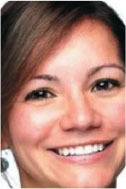Community health workers (CHWs) are non-clinical members of the community who usually share ethnicity, language and life experiences with the community members they serve (NIHLBI, 2023). Traditionally, CHWs are social and change agents; they reduce disparities and inequities by expanding knowledge and access to benefits and community services. Community health workers have vast knowledge of the local community and its resources, and experience navigating systems and working in other community-based organizations, but an advanced degree is not required to fulfil the role. Certification is available in many states, but a centralized standard for community health worker certification does not exist at this time. The Centers for Medicare & Medicaid Services (CMS) is currently seeking a request for information to initiate reimbursement for community health worker services because several randomized control trials showcase positive outcomes (Carter, et. al., 2021; Kangovi, et. al, 2018).
In this article we will share how CenterWell, a division of Humana, uses an innovative community health worker model to develop personalized care plans in collaboration with an interdisciplinary team for high-risk senior patients (Tinetti, et al., 2017). The model is built upon the geriatric best practice framework called 5Ms. To our knowledge, this is the first community health worker program to adopt this geriatric evidence-based practice in a team-based approach.
CenterWell is the nation’s largest value-based care primary care provider, with approximately 250 centers spread across 12 states, serving over 250,000 seniors. CenterWell’s mission is to help seniors live healthier and happier lives by building the nation’s premier senior-focused primary care centers. To care for seniors, we promote an interdisciplinary team-based approach, leveraging a range of different professionals to collaboratively support and address patient needs including registered nurses, behavioral health specialists, pharmacists, resource coordinators and most recently including community health workers. All team members work together to drive toward increasing patient engagement in care and improving overall clinical outcomes for the patient population.
The community health workers are engaging patients identified as high risk, defined by high utilization of acute hospitalization and emergency care, with historical low engagement with the center to which they are assigned. Patients identified as high risk also have multiple chronic conditions, with large numbers having behavioral health co-morbidities and social needs. Some patients may never have been to the clinic and may not yet be assigned to a provider but would have the opportunity to receive a visit from a community health worker to begin to share what roadblocks they may be facing in taking care of themselves.
In the CenterWell model, the community health worker serves as a funnel, to collect observations and information from a home visit which often cannot be gleaned from a clinic appointment. As the CHW engages with a patient who may respond in an appointment that food is not a concern, a community health worker could observe that there is no food in the fridge. If an urgent need arises during a home visit and a patient is willing to receive assistance, the community health worker has the skills and the knowledge to address the need in the moment, arranging food, providing emergency shelter resources or utility payment assistance as needed.
To support the community health worker in developing a personalized care plan, we have developed tools based on evidence-based questionnaires to screen and address key social drivers of health and behavioral health screening tools that would facilitate a referral to a treatment pathway in partnership with our behavioral team. While there are multiple different options for social needs screening available today, the community health workers employ a modified version of CMS’ Accountable Healthcare Communities Health-Related Social Needs screening tool. While this 26-question tool can be overwhelming in its full form, the community health workers administer a modified version with focused questions on housing, food, transportation, financial strain and safety. In crafting a custom intake assessment, additional questions have been added to assess ability to access, manage and obtain medications tailored to the clinics’ older adult population. The community health workers are also trained to administer the PHQ-2 to assess for concern for depressive symptoms and proceed with PHQ-9 screening if the patient scores positively on the PHQ-2. Community health workers must be trained to respond to behavioral health crisis scenarios in the event that the patient responds positively regarding thoughts of self-harm. While most community health workers will be experienced in dealing with various emergent situations in the field, the importance of this training and education cannot be overstated.
Our most innovative toolkit in this program is leveraging the Geriatric 5M communication framework. This communication framework is used by every Age Friendly Health System and has been shown to improve health outcomes when used by all members of a care team. The 5Ms describe five domains of a personalized geriatric care plan. These include Mind, Mobility, Medications, Multicomplexity and Matters Most to me.
Each domain has patient-centered questions that focus on the patient’s goals and identifying the barriers the patient sees in achieving such goals. For example, “Matters Most to me” guiding questions include: “What is important to you today?” “What brings you joy and makes you happy?” “What do you worry about?”
The Mind “M” focuses on the patient’s mental health and changes related to cognitive disorders that may impact the patient’s well-being and independence. The Mobility “M” focuses on identifying factors related to falls, which is a threat to the health and well-being of older adults. The Medications “M” focuses on polypharmacy, medication adherence and high-risk geriatric medications (such as benzodiazepines). Finally, the Multicomplexity “M” focuses on social drivers and multiple co-morbidities that impact the patient’s overall health. In developing a 5Ms care plan, our community health workers work hand in hand with our behavioral health providers to review the Mind, our clinical pharmacists to review the Medications, our nurses and social workers to review the Multicomplexity. With the patient’s provider, they create a personalized care plan that is used to manage the patient’s goals over three to six months.
The care plans are reviewed every time a patient presents to the center for an appointment and frequently during our center interdisciplinary team meetings, where all team members participate in the patient’s progress and focus on addressing key challenges together.
While CenterWell’s program remains in its pilot phase, the future goals of the program will involve both an intentional focus on partnership with community-based organizations to increase patient engagement at other organizations which they may frequent, as well as the utilization of technology to directly facilitate access to virtual care from the patient’s home. While typically the community health worker could assist with set up and education for the patient on how to engage with the available virtual care options to conduct a visit with a provider, often patients do not own a device to sufficiently support this or have reliable internet access. Supplying iPads that are equipped and ready to connect patients with a provider within the clinic will bring care directly to patients who would struggle to present to the clinic even when transportation assistance could be provided.
Through the development of the community health worker pilot, we developed a series of lessons learned for others that are thinking about starting such a program.
CHW programs need to meet patients where they are — literally and figuratively. While we may have a predetermined sense of which goals will best address the patient’s needs, engaging in this work requires the patience and flexibility to address the need that the patient identifies as the main concern first. This gives us the opportunity to demonstrate to the patient that they can trust us and we can help. Being invited into someone’s home is a privilege not to be taken for granted, but if a patient doesn’t have a home or prefers to meet elsewhere in the community, we have to be willing to take the offer.
There is a need for unique and creative problem solving. Anyone who has worked in the field in any discipline or capacity will tell you that there’s no predicting some of the scenarios that will arise, and some of the problems that patients will require assistance with. There is always the opportunity to learn more in terms of the types of resources for which you will need to search and supports you will need to provide.
Maybe we can’t solve the problem we set out to, but that doesn’t mean there’s nothing we can do. It’s imperative to mention that despite the best of intentions, not all barriers that a patient presents with will be able to be removed. When a patient is in need of housing, this can take years to come to fruition if at all. However, it is important to not lose sight of the importance of conducting a comprehensive assessment and remaining open minded to other referrals, services and supports that may provide some relief.
For our population, there is significant impact related to social isolation and the importance of the relationship. Social isolation has been shown to have a direct correlation with and impact on physical health for older adults. Approximately 1 in 4 older adults aged 65 and older are socially isolated (CDC, 2023). Isolation and loneliness are linked to increased risk of heart disease, stroke, Type 2 diabetes, depression and anxiety, dementia and earlier death (CDC, 2023). Isolation increases the risk of dementia by 50%, of heart disease by 29% and of stroke by 32% (CDC, 2023). There is intrinsic value in the connection fostered by engaging with a community health worker who is there to take the time to visit and to listen for those who may not have others in their lives who can do so.
In summation the inclusion of community health workers in the interdisciplinary care team whether on the care delivery or the payor side can offer significant value in increased patient engagement and the removal of social determinant of health barriers to access to care. As CenterWell continues to pilot this program, attention will be given to monitoring downstream impacts on acute utilization and total cost of care, as well as ROI after increased patient benefit enrollment, to demonstrate the ongoing value of the program. We are also excited to see that CMS is seeking a request for information on reimbursing for CHW services as a form of recognition on the positive impact that CHWs play in the delivery of healthcare services.
We would like to give a special thanks to Dr. Theresa Brown and Dr. Bill Russell for their input and collaboration in creating the CenterWell Community Health model.
Image credit: ISTOCK.COM/WILDPIXEL






